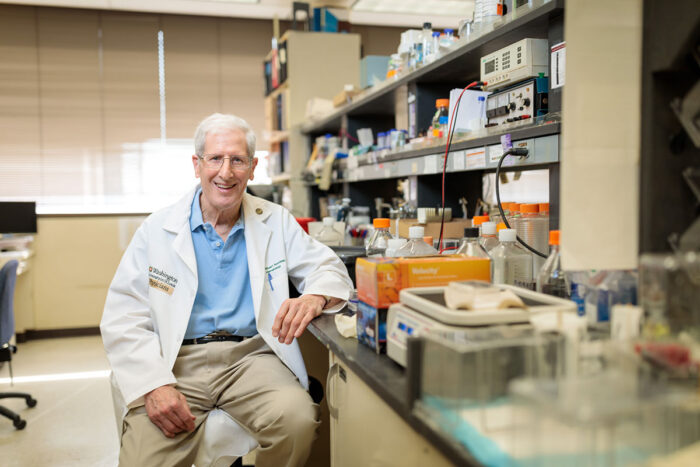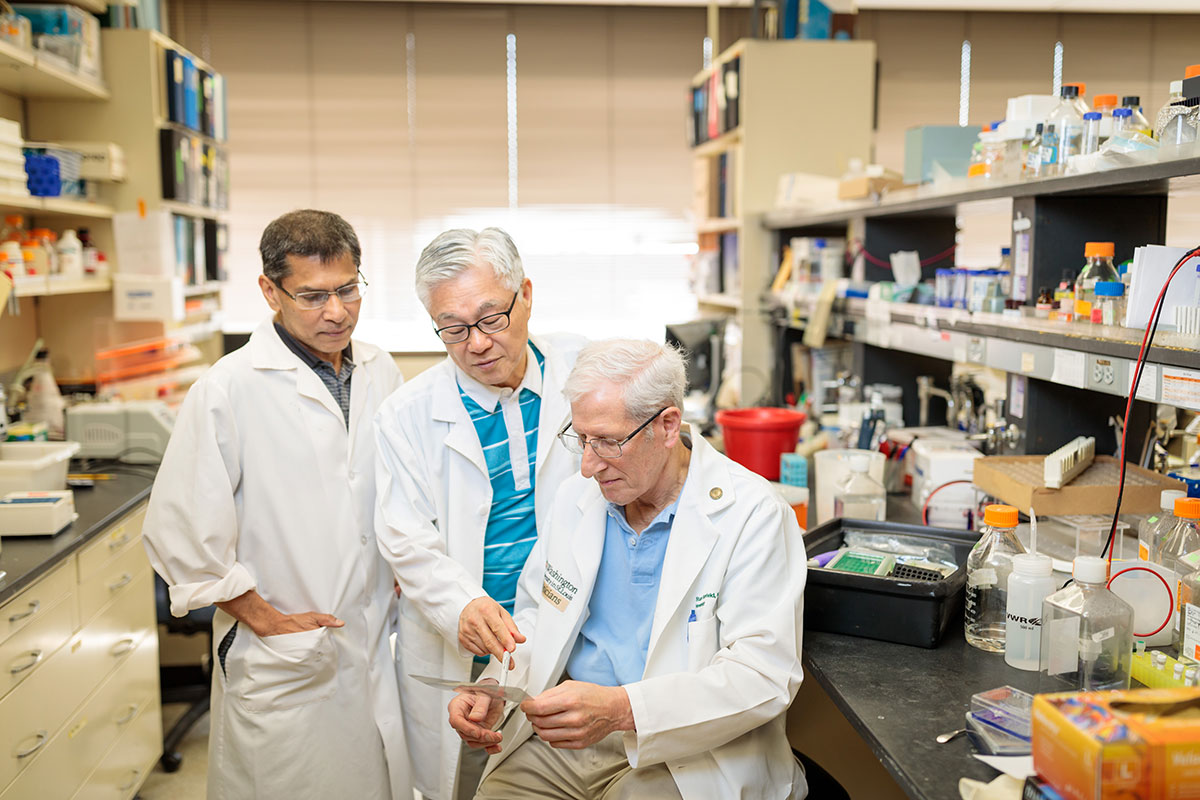Half-century of research illuminates how cells work in health, disease
Kornfeld reflects on knowledge gained from longest running NCI grant
 Matt Miller
Matt MillerStuart Kornfeld, MD, has led the field of glycobiology — the study of sugars bound to proteins — for decades, fueled by the same grant from the National Cancer Institute (NCI) that first supported his lab more than 50 years ago. He reflects on his career and the advances made possible by the NCI's longest running research grant.
As a medical resident at Washington University School of Medicine in St. Louis more than 50 years ago, Stuart A. Kornfeld, MD, was awarded his first research grant. The year was 1966. The final keystone section of St. Louis’ Gateway Arch recently had been welded into place.
Kornfeld’s grant — from the National Cancer Institute (NCI) of the National Institutes of Health (NIH) — enabled him to set out on an emerging field of study that would lay the foundation for understanding cells’ behavior in health and a number of devastating inherited diseases. He launched his studies into the role that glycoproteins — sugars attached to proteins — play in how cells function, and whether the cells are healthy, cancerous or in other disease states.
When Kornfeld started his lab, biochemists knew that mammalian cells are coated with sugar molecules attached to proteins. This coating had been observed under electron microscopes, but almost nothing was known about what it did.
“We knew that blood group types — A, B and O — are determined by sugars on the surface of red blood cells,” said Kornfeld, the David C. and Betty Farrell Distinguished Professor of Medicine. “The difference between type A and B is a single sugar molecule. It seemed to me that sugars on the surfaces of cells must have other important roles. Very few people were working on this question, and I thought it would be a wide-open area to explore in my lab.”
This year, more than five decades after Kornfeld began his research, the NCI renewed this grant once again, providing just over $3.4 million over the next five years to continue delving into the roles of glycoproteins in cells, revealing how they work properly in health and go astray in disease.
According to data from the NCI, Kornfeld’s grant supporting glycoprotein research is the NCI’s longest continuously running research grant. It is an R01 grant, arguably the most important funding engine fueling medical science across the country. Over that time, the field of glycobiology — the study of chains of sugars and the proteins they bind, including their structures and functions — exploded and has shed light on fundamental cellular processes, such as protein folding, cellular movement and immunity.
“I commend the NCI for their willingness to support the kind of basic scientific research that we do,” said Kornfeld, of the university’s hematology division. “Without basic research, there’s no way to get to applied research that has the potential to help patients in the clinic. Some of the knowledge, from our lab and others, has formed the basis of new therapies for patients with inherited genetic diseases. We look forward to continuing our work, helping to understand the fundamental processes underlying how cells’ work, including how their functioning can go wrong in cancer and other disorders.”
Over its 50 years of research, Kornfeld’s lab has produced papers that have become classics in the field, including one — co-authored by his wife, collaborator and fellow Washington University glycobiology pioneer, Rosalind Hauk Kornfeld, PhD — that has been cited more than 4,200 times and counting. The two led the glycoprotein field for decades, co-authoring many seminal papers before her death in 2007.
The Kornfelds’ work has been included in standard sections of biochemistry textbooks and led to new understandings of inherited disorders called lysosomal storage diseases, including, for example, Gaucher disease, Pompe disease, mucolipidosis and Tay Sachs. Lysosomes are the garbage disposals and recycling centers of cells, where lysosomal enzymes digest waste molecules and help get rid of viruses and bacteria. Though the details differ in each case, all lysosomal storage disorders are characterized by the damaging buildup of toxic waste in cells. Severe forms of these diseases are often fatal.
Kornfeld’s research is focused on understanding how proteins are packaged and transported through cells. A big part of that mystery has involved unraveling how sugar chains are made and how they attach to proteins. Sugar chains serve as a sort of address label, directing proteins to the right part of the cell so the protein machinery is in the right place at the right time to do its job. In mucolipidosis, for example, lysosomal enzymes are not properly addressed to the lysosome, so they end up outside the lysosome, where they can’t do their recycling and cleanup jobs, leading to waste buildup. Severe forms of mucolipidosis are eventually fatal.
Uncovering the details of the packaging and transporting of lysosomal enzymes are among Kornfeld’s most well-known discoveries. He and members of his lab described how vital lysosomal enzymes are transported from where they are manufactured in cells to where they are needed in the lysosomes.
Though Kornfeld is quick to deflect credit to other labs for work developing treatments for certain lysosomal storage disorders, that work would not have been possible without his lab’s research describing how important enzymes travel to the lysosome via what is called the mannose-6-phosphate pathway. Kornfeld and his colleagues laid out the workings of this pathway in a classic set of papers published in the 1980s.
 Matt Miller
Matt MillerKornfeld has marveled at how much has changed over the span of his career. In the late 1960s, a staff scientist working in a typical lab could expect an annual salary of about $5,000. But the revolution in technology might be even more staggering.
“The equipment we use today in the lab bears almost no resemblance to what we had 50 years ago,” he said. “We do things now that were totally unimaginable then, like having the ability to inactivate a gene. When we started, the idea of giving a mouse a human disease by deliberately mutating a specific gene was science fiction. And I would say that the vast majority of the major discoveries that led to these kinds of advancements have been funded by the NIH.”
Despite these great changes, Kornfeld stressed that the goals they had in 1966 are basically the same today: to further elucidate the roles of glycoproteins in cell function.
“I was fortunate to enter a field when it was in its infancy and to have the opportunity to watch it expand into an area that impacts almost every aspect of biology and, by extension, health and disease,” he said. “When we first started, we weren’t even sure that proteins specifically for binding sugars existed in mammals. Not only do they exist, they play fundamental roles in all sorts of biochemical processes required to keep people healthy. Although our work is very basic, almost every area we have explored has proven to have clinical significance. None of the progress I have described would have occurred without the generous support of the NCI. There is still much to learn, and we are grateful for their ongoing support.”






